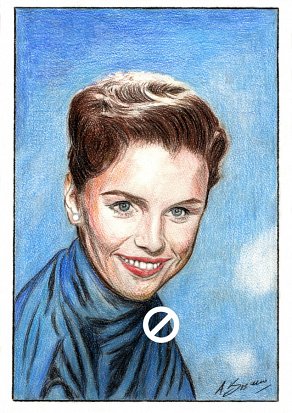Lee Remick
Pencil Portrait by Antonio Bosano.

Shopping Basket
The quality of the prints are at a much higher level compared to the image shown on the left.
Order
A3 Pencil Print-Price £25.00-Purchase
A4 Pencil Print-Price £20.00-Purchase
*Limited edition run of 250 prints only*
All Pencil Prints are printed on the finest Bockingford Somerset Velvet 255 gsm paper.
P&P is not included in the above prices.

Recommended viewing
Anatomy of a murder (1959)
The Days of Wine and Roses (1962)
Experiment in Terror (1962)
No Way to treat a Lady (1968)
Engaging and highly decorative in equal measure, Lee captivates detective Mo Brummel in this delightful black comedy thriller. It’s Steiger’s show, but the ensemble cast all work well.
He plays psychopathic serial killer Christopher Gill, who is obsessed with his late mother, targets victims who remind him of her. He dons various disguises to gain his victims’ trust and always leaves his calling card, a red lipstick mark, when he’s done. Christopher begins deliberately tipping off detective Morris Brummel (George Segal) on the phone, drawing the detective, who has issues with his own overbearing mother (Eileen Heckart), into a game of cat and mouse.
I saw the movie on the big screen with my parents and was entranced by Steiger’s multi- faceted performance. Employing more accents than you might have heard in a year of vaudeville, it seemed unfair to my young impressionable mind that his one failed murder attempt should have occurred whilst stylishly attired as a fag hairdresser. With an accent worthy of Dick Emery no less, dear Rod hams up the scene to its fullest potential, replete with blonde wig, sunglasses and mock horror indignation. Today’s wokes would be appalled, I’m thrilled to say. The film never loses its sense of humour, which is more than one can say about 21st century snowflakes.
Playing mouse to Steiger’s cat is George Segal, the detective assigned to solve the mystery of the stranglings and who is, oddly, as much of a caricature as the flamboyant killer who taunts him. Dominated by a Jewish mother so extravagantly played by Eileen Heckart, dear Mo might dream of matricide but remains throughout, frustrated and dutiful in equal measure.
Remick, the Minnie Mouse of the cartoon—a beautiful blonde with no visible means of support, a self-described former swinger and the kind of girl who sleeps in her false eyelashes— falls for Mo’s nose and shy affability. One can only prey she’s on the level, as the castrating putdown artist she humorously affects to be in her first meeting with Segal’s harridan-mother, is truly disturbing.
John Gay’s script, adapted from the William Goldman novel, makes nothing much of this Oedipean hang-up common to both cat and mouse nor does it offer more than the sketchiest motivations for anything that happens. Instead, Mr. Gay has written an exposition-free, gag-filled cartoon, which is the manner in which Jack Smight directs it. “No Way to Treat a Lady” is all contemporary surface action, with quick cuts between scenes of murder and comedy and sometimes between scenes that combine both. Luckily, despite the fact that it was beautifully photographed in colour entirely in New York, it has absolutely no reality.
Smight has got some fine performances from his supporting players, including Barbara Baxley, Martine Bartlett, Ruth White and Michael Dunn as a pint-sized creep who tries to confess to the crimes. “You’d believe me,” he tells the detective waspishly, “if I weren’t a midget!” As with the film itself, there is something both funny and oddly disturbing in this aggressive lack of logic.


Comments
Last Update : 4/9/22
I recently re-acquainted myself with the neo-noir suspense thriller “Experiment in Terror. “ Released by Columbia Pictures in 1962, it offered no clues as to the forthcoming comedic direction Blake Edwards would take with the Pink Panther franchise only a year later.
In the movie, a sadistic asthmatic killer, “Red” Lynch, uses a campaign of terror to force a San Francisco bank teller Kelly Sherwood to steal $100,000 from the bank for him. Despite Lynch’s threat to kill Sherwood or her teenage sister Toby if she goes to the police, Sherwood contacts the San Francisco office of the FBI, where agent John Ripley (Glen Ford) takes charge of the case.
It boasts a terrific suspenseful opening sequence in Kelly’s garage and a climactic shoot out at the Candlestick Park stadium, scene of The Beatles last live show before a paying audience four years later.
Featuring a first rate performance from the Tony and BAFTA award winning actress Lee Remick, it’s another reminder of her untimely loss to the movie world in 1991 at the age of 55. As well as her acting ability, she was – as George Segal so succinctly put it in his co-starring role with her in “No Way To Treat a Lady” (1968) – “very pretty.”